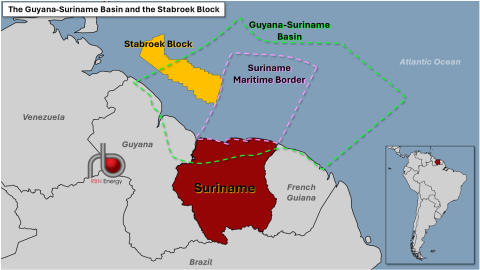Locator: 48468SURINAME.
Re-posting:
RBN Energy: today, more recent -- Suriname sets its site on becoming major oil supplier with offshore boost. Archived.
As crude oil production surges off the coast of Guyana, its eastern neighbor, Suriname, has set off on its own mission to become a global oil supplier. With some onshore production active for decades, the tiny South American nation now has its sights set on developing its vast offshore reserves. While there have been some setbacks, its international partners are getting their plans back on track. In today’s RBN blog, we’ll take a deep dive into what’s ahead for Suriname.
We previously highlighted how Guyana has been a rising star (see Break My Stride) in the global crude market, even if it’s only a recent entrant. Guyana now has three crude grades to offer markets (see My Guy) since its first major oil discovery just a decade ago. The offshore Stabroek block’s only oil-producing area (yellow-shaded area in Figure 1 below) is churning out more than 650 Mb/d of oil from three projects in the reserve-rich Guyana-Suriname Basin (area within dashed-green line). Owners of these assets want to roughly double that volume by the end of 2027 with three more projects. It’s worth noting that in 2000, the U.S. Geological Survey (USGS) estimated that the underexplored areas of the Suriname-Guyana Basin held 13.6 billion barrels of oil and 32 trillion cubic feet (Tcf) of gas. But Guyana isn’t the only country with plans to develop those reserves.
Figure 1. The Guyana-Suriname Basin and the Stabroek Block. Source: RBN
The Guyana-Suriname Basin stretches across three countries on the Atlantic coast of South America: Guyana, Suriname and French Guiana. The oil-rich formation has an onshore segment but is predominantly an offshore play. Suriname has been extracting minimal amounts of crude oil from the onshore basin since the 1980s but the former Dutch colony wants to raise its profile as a petroleum supplier with its offshore oil bonanza, mirroring its neighbor’s success. (Suriname’s maritime border indicated by dashed-pink line in Figure 1.)
Suriname’s crude production predates the E&P activities of neighboring Guyana by more than three decades. According to state-owned Staatsolie, which was created in 1980, authorities struck oil in 1965 while trying to drill for water in a schoolyard in the town of Calcutta (yes, it was named after the city in eastern India, now known as Kolkata). The town is in the Saramacca district, west of Suriname’s capital, Paramaribo. But commercial oil production only began 17 years later, in 1982. Supplies were extracted from the Tambaredjo field and the oil grade, Saramacca, was named after the district, with flows starting at 200 b/d. Oil from the field was initially sent on the Saramacca River by barge to Staatsolie’s terminal in Tout Lui Faut, south of the country’s capital. Then, a pipeline was laid to connect the producing area with the terminal.

No comments:
Post a Comment
Note: Only a member of this blog may post a comment.